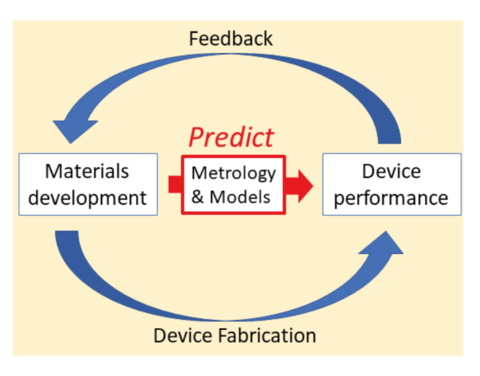Summary
Ferromagnet-based microelectronic devices play an increasingly important role within the semiconductor ecosystem. Magnetic RAM (MRAM) is already replacing embedded Flash memory and is being considered for last-level cache in processors.
This project will address the critical industry need for precise measurement of magnetic material and device parameters by expanding measurement methods first developed at NIST.
Grand Challenge 4: Modeling and Simulating Semiconductor Materials, Devices, and Components
Description

Today, device performance needs to be evaluated to determine success of materials development. This project will advance metrology for magnetic materials and develop models to predict device performance.
The U.S. Semiconductor industry is integrating ferromagnet-based microelectronic devices such as magnetic RAM (MRAM) into existing silicon-based technologies. MRAM has much shorter write times and higher write endurance than the embedded Flash currently used. These properties makes MRAM highly attractive for many applications, with embedded MRAM already replacing Flash for some applications such as automotive technologies.
MRAM is also being considered for last-level cache applications in processors, but there are materials development challenges to overcome. In particular, the saturation magnetization needs to be lowered to accelerate the write speed, while still maintaining other critical device properties such as thermal stability and bit error rate. However, the lack of accurate film-level measurements of materials parameters that are critical to these and other performance metrics results in device models that cannot deliver accurate predictions for a given materials change, significantly slowing the development cycle.
This fundamental measurement gap leads to large uncertainties in predictive models of MRAM device performance. Thus, testing a new material requires fabricating and testing fully functional devices - a slow and expensive process. The semiconductor industry has expressed that even simple measurements ranking the relative strength of the exchange of candidate materials would significantly accelerate materials development.
This project will produce measurements and methods that will enable industry to improve models to significantly accelerate the magnetic device development process.
This project will provide and advance unique measurement capabilities for magnetic materials parameters, inform models for magnetic device performance, and advance measurement approaches for characterization of materials parameters relevant to the microelectronics industry.
Hans Nembach, Daniel Gopman, Matt Pufall, Jenae E Shoup, William Kenneth Peria (2024), Evaluation of static and dynamic magnetic properties of CoFeB versus thickness, National Institute of Standards and Technology, https://doi.org/10.18434/mds2-3408

